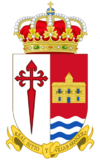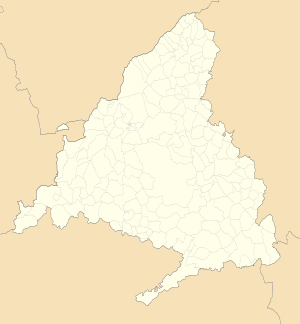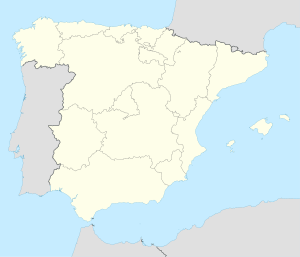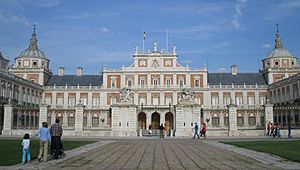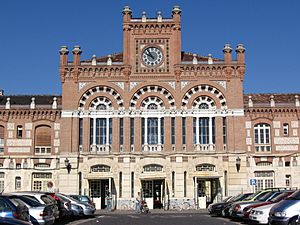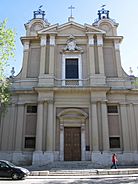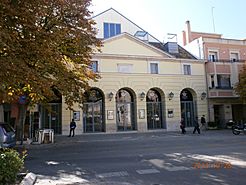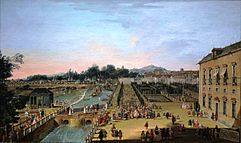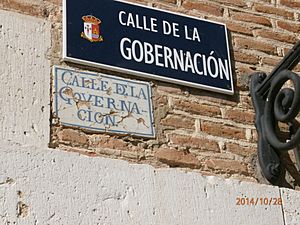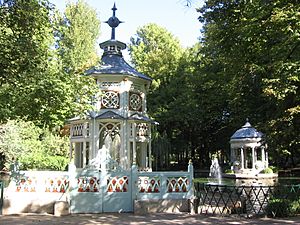Aranjuez facts for kids
Quick facts for kids
Aranjuez
|
|||
|---|---|---|---|
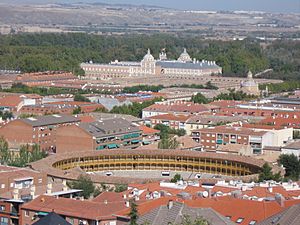
The Royal Palace and the Bullring of Aranjuez seen from El Mirador Housing Estate Hill
|
|||
|
|||
| Country | Spain | ||
| Autonomous Community | Community of Madrid | ||
| Area | |||
| • Total | 201.11 km2 (77.65 sq mi) | ||
| Elevation | 495 m (1,624 ft) | ||
| Population
(2018)
|
|||
| • Total | 59,037 | ||
| • Density | 293.556/km2 (760.306/sq mi) | ||
| Demonyms | ribereño, arancentano | ||
Aranjuez is a city and a special area in Spain. It is part of the Community of Madrid.
The city is located in the southern part of the region. Its main area sits on the left side of the Tagus river. This is just a bit upstream from where the Jarama river joins it. In 2022, about 59,762 people lived in Aranjuez.
Aranjuez became a Royal Estate for the Spanish Crown in 1560. This happened during the time of King Philip II. Until 1752, only the royal family and nobles were allowed to live in the town.
In 2001, UNESCO named the cultural landscape of Aranjuez a World Heritage Site. This means it's a very important place for everyone to protect.
Contents
What's in a Name?
There are a few ideas about where the name Aranjuez comes from. The most popular idea says it comes from the Basque word arantza. This word means "hawthorn", which is a type of thorny bush.
Another idea suggests it comes from the Latin words Ara Jovis. This means "altar of Jupiter", who was a Roman god. However, most people think the name came from before the Romans.
Aranjuez Through Time
Early Days
Alfonso VI took control of the land around the Tagus river, including Aranjuez, in 1085. This happened after he conquered the city of Toledo.
In the 12th century, Aranjuez was a small village. It was influenced by the nearby castle of Oreja. After a battle in 1108, the area was controlled by Muslim forces.
Later, King Alfonso VII took back Oreja in 1194. In 1171, Alfonso VIII gave Oreja and its villages to the Order of Santiago. This was a special group of knights. Aranjuez was fully secured by them in 1178.
In 1272, Aranjuez became the main place for the "Master's Table" of the Order of Santiago. The connection between Aranjuez and the Spanish Crown began in 1493. This is when the Catholic Monarchs started managing the military orders.
Becoming a Royal Place
King Philip II declared Aranjuez a Royal Site in 1560. In the late 1500s, the royal palace was built. The town's name changed from Alpajes to Aranjuez.
The palace was first designed by Juan Bautista de Toledo. Juan de Herrera finished the work. In the 1700s, Santiago Bonavía greatly redesigned Aranjuez.
In 1752, during the rule of King Ferdinand VI, Aranjuez began to open up. Before this, only the royal family and nobles could stay there. Now, visitors could find places to stay overnight.
A weir (a small dam) was built in the Tagus River in 1753. It was next to the Royal Palace. This weir helped power a water wheel to grind wheat flour.
King Charles III built the Long Bridge, which is about 300 meters long, over the Jarama river in 1761. In 1763, King Charles III also ordered the building of the Real Cortijo de San Isidro. This was a special farm.
Two years later, the king ordered the building of the Franciscan Convent of San Pascual. The French architect Jaime Marquet started building the Coliseum Carlos III theatre in 1767.
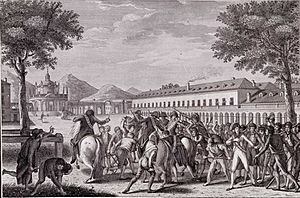
A famous event called the Mutiny of Aranjuez happened on March 17, 1808. The royal family was in Aranjuez, expecting a French invasion. Soldiers and people attacked the home of Manuel Godoy, a powerful minister, and captured him. The people forced the king to remove Godoy. Two days later, the king had to give up his throne to his son, who became Ferdinand VII.
More Recent Times
The railway came to Aranjuez on February 9, 1851. This was with the opening of the line from Madrid to Aranjuez. Aranjuez was given the title of "town" (villa) in 1899.
During the Spanish Civil War (1936–1939), Aranjuez stayed under the control of the Republic. It became a headquarters for a part of the Spanish Republican Army. Important battles happened near Aranjuez.
Cool Places to See
| Aranjuez Cultural Landscape | |
|---|---|
| Official name: Aranjuez Cultural Landscape | |
| Type | Cultural |
| Criteria | ii, iv |
| Designated | 2001 (25th session) |
| Reference no. | 1044 |
| Region | Europe and North America |
The city was named a "Historic Artistic Junction" in 1983. In 2001, UNESCO made the Aranjuez Cultural landscape a World Heritage Site.
Mariblanca Square
This was the first area built outside the Royal Palace. It is along the south bank of the Tagus river. The royal Church of San Antonio is here. It was built by Philip IV of Spain for both public and royal use.
The square is known as Mariblanca. This name might come from "sea of white sand" (mar de arena blanca). Or it could be about the white statue of Venus in the fountain.
The Bullring
The bullring is one of the oldest in Spain. The first one was built in 1760 by order of King Charles IV. His wife, Maria Luisa of Parma, opened the rebuilt structure in 1797. It could hold 9,000 people. At that time, the town only had about 4,226 people!
After a fire in 1809, King Ferdinand VII had it rebuilt. He then gave it to the town. Today, it has a small museum that is usually open on Saturday, Sunday, and Monday mornings.
Other Buildings
Besides the Royal Palace and church, there are many other interesting buildings:
- House of Trades and Knights
- House of Infantes and Atarfe
- Pleasure craft Museum
- Farmhand's House
- House of Employees (now the Town Hall)
- Alpajes Church
- Saint Pascual's Royal Convent
- Old Saint Charles' Hospital (being restored)
- Charles III's Royal Theatre (restored and reopened in 2014)
- Supply Market
- Plaza de Toros and Bullfighting Museum "Una Gran Fiesta"
- Medinaceli Palace
- Governor's House (now a university center)
- Mother Queen's old garage (now a cultural center)
- Typical 'corralas' (buildings with balconies around a central courtyard)
- Godoy and Osuna Palaces
- Silvela's Palace (also called Bavaria's Palace)
- Royal Country Estate of Saint Isidro
Parks and Gardens
Many beautiful parks and gardens are open to visitors:
- Isle Garden – north of the palace, next to the river.
- Parterre Garden – a formal garden with fountains in front of the palace.
- Prince's Garden – along the river to the east.
- Isabella II's Garden – a small formal garden near Mariblanca.
- Old forests and woodlands.
- Center for the Natural Reserve "El Regajal-Mar de Ontígola."
- Tree-lined paths through old nursery gardens.
Weather in Aranjuez
Aranjuez has a semi-arid climate. This means it has cool winters and hot, dry summers.
| Climate data for Aranjuez, 1981–2010 | |||||||||||||
|---|---|---|---|---|---|---|---|---|---|---|---|---|---|
| Month | Jan | Feb | Mar | Apr | May | Jun | Jul | Aug | Sep | Oct | Nov | Dec | Year |
| Mean daily maximum °C (°F) | 11.7 (53.1) |
14.0 (57.2) |
18.1 (64.6) |
19.8 (67.6) |
24.1 (75.4) |
30.4 (86.7) |
34.4 (93.9) |
33.7 (92.7) |
28.7 (83.7) |
21.8 (71.2) |
15.7 (60.3) |
11.8 (53.2) |
22.0 (71.6) |
| Mean daily minimum °C (°F) | 0.3 (32.5) |
1.2 (34.2) |
3.6 (38.5) |
5.5 (41.9) |
9.3 (48.7) |
14.0 (57.2) |
16.5 (61.7) |
16.2 (61.2) |
12.9 (55.2) |
8.5 (47.3) |
3.8 (38.8) |
1.4 (34.5) |
7.8 (46.0) |
| Average rainfall mm (inches) | 23.0 (0.91) |
25.3 (1.00) |
22.8 (0.90) |
38.4 (1.51) |
43.0 (1.69) |
18.7 (0.74) |
6.5 (0.26) |
5.6 (0.22) |
20.9 (0.82) |
49.8 (1.96) |
39.0 (1.54) |
41.5 (1.63) |
334.5 (13.18) |
| Source: World Meteorological Organization | |||||||||||||
How Aranjuez Makes Money
The main ways Aranjuez makes money are through hotels and tourism. Aranjuez has always been popular with tourists. People love its Royal Palace, beautiful gardens, the Tagus river, and lovely scenery.
When UNESCO named it a World Heritage Site in 2001, even more tourists started visiting. Before 2008, a lot of money was spent to make Aranjuez even more beautiful. Many new pubs and restaurants opened.
Farming in Aranjuez
Aranjuez is in a fertile valley near the Tagus river. The rich soil is great for growing wheat and other grains. There are also many farms for fruits and vegetables. These include asparagus and strawberries.
Nearby areas also grow vineyards and lots of melons. You can also find products like sorghum, sunflowers, potatoes, and tomatoes.
The Real Cortijo de San Isidro is a village about 6 km north of Aranjuez. King Charles III started a royal farm there in 1766. It has a village with a royal chapel and a wine cellar.
Local Industries
Aranjuez is close to Madrid and has good roads and railways. This makes it a good place for factories. Some industries here include:
- Indra Sistemas (high-tech computer systems for defense)
- Electrónica Aranjuez (electronics for defense)
- Bosch (electrical parts for cars)
- Carburos Metálicos (medical and industrial gases)
- FYSE Pharmaceuticals (medicines)
- Cortefiel (clothing logistics for brands like Springfield)
- API Fabricación (road signs)
Getting Around
Aranjuez has great road and rail connections to Madrid.
Road Travel
The public highway Autovía A-4 connects to Aranjuez. You can take exit 37 to the M-305 road, which goes straight to the royal palace. Exit 52 on the A4 serves the south of town. There is also a toll road called Radial R-4.
Six main bus routes serve the area through the Las Infantas bus station. Taxis and local buses connect to the railway station. The city also has a free public bicycle sharing program.
There is a tourist "Chiquitren road train" that tours the town and the large jardin del principe royal garden.
Train Travel
The Aranjuez railway station building is very decorative. It was built between 1922 and 1927. RENFE operates hourly trains to Madrid and other places. The Strawberry train is a special steam train service for tourists in the summer.
River Use
The Tagus river in Aranjuez is used by a local tourist boat and for canoeing. There is also a fun rafting competition each year.
An old system of channels and a waterwheel helps water the royal gardens. This area is now a leisure spot called Talud Sur.
Local News and Entertainment
Printed News
- Heraldo de Aranjuez
- Tablón de Anuncios
- Consumo Digital
- Cuatro Esquinas
- Divergente
- El Espejo
Radio Stations
- Onda Aranjuez, 107.8 FM
- Cadena Ser Aranjuez, 89.3 FM
- Onda Cero Aranjuez, 90.7 FM
- Radio Fuga, 92.1 FM
Sports and Fun
- Aranjuez is known for water sports on the Tagus river. These include canoeing, stand-up paddleboarding, and rowing. Aranjuez was chosen as the site for these sports if Madrid had hosted the 2012 Summer Olympics.
- Aranjuez has a football team, Real Aranjuez C.F.. They play at the "El Deleite" stadium.
- Nearby Ocaña has a skydiving and gliding center. Many skydivers stay in Aranjuez.
- Aranjuez has an 18-hole golf course.
Famous People from Aranjuez
- Infante Carlos, Count of Molina (1788–1855), a Spanish prince.
- Francisco Clavet, a tennis player.
- Francis, Duke of Cadiz, husband of queen Isabella II of Spain.
- Javier García Portillo, a football player.
- Ángel Parra, a judo athlete.
- Joaquín Rodrigo, a famous composer.
- Santiago Rusiñol, a painter.
- Jose Luis Sampedro, a writer.
- Iván Sánchez-Rico Soto (Riki), a football player.
- Francisco Agustín Silvela y Blanco, a government minister.
- Carlos Suarez, a basketball player.
Aranjuez in Books and Music
The play Don Carlos by Friedrich Schiller begins with the line: "The beautiful days in Aranjuez are now over."
Joaquín Rodrigo wrote the famous Concierto de Aranjuez (1939). This music for guitar and orchestra was inspired by the royal gardens of Aranjuez. It became one of the most famous orchestral pieces of the 20th century.
The Austrian writer Peter Handke wrote a play called Die schönen Tage von Aranjuez (The beautiful days of Aranjuez).
Culture and Fun
Traditions
In summer, it's a tradition to have dinner in the picnic areas by the Tagus river. These spots are called gangos, a special word used only in Aranjuez.
Festivals
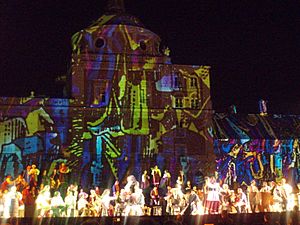
- Alfaranjuez In May – This includes a Craft Fair and a Traditional Music Festival.
- San Isidro Labrador day, May 15 – A special trip to the nearby royal farm.
- San Fernando town festival week, around May 30 – With parades and events.
- Early Music Festival Aranjuez, held in May or June.
- Book Fair Aranjuez, in September.
- Mutiny of Aranjuez re-enactment – This happens around the first week of September. It's a big cultural event with:
- A funfair.
- Sports events.
- Food and drink stalls.
- A concert at the Royal Palace.
- A traditional bullfighting event.
- A dramatic street play of the attack and capture of Godoy. This includes fireworks and costumes.
- A fun raft race on the river.
Local Food
Aranjuez is known for its local farm products, especially:
- Strawberries and asparagus.
- Sweet, green toadskin melons.
- Olive oil and local wine from nearby farming areas.
- Pheasant, a type of game bird found in the local forests.
Sister Cities
| Town | State/Region | Country |
|---|---|---|
| Écija | Andalusia | Spain |
| Le Pecq | Yvelines | France |
Other Towns Nearby
- Algodor
- Castillejo
- Las Infantas
- Real Cortijo de San Isidro
Images for kids
See also
 In Spanish: Aranjuez para niños
In Spanish: Aranjuez para niños



